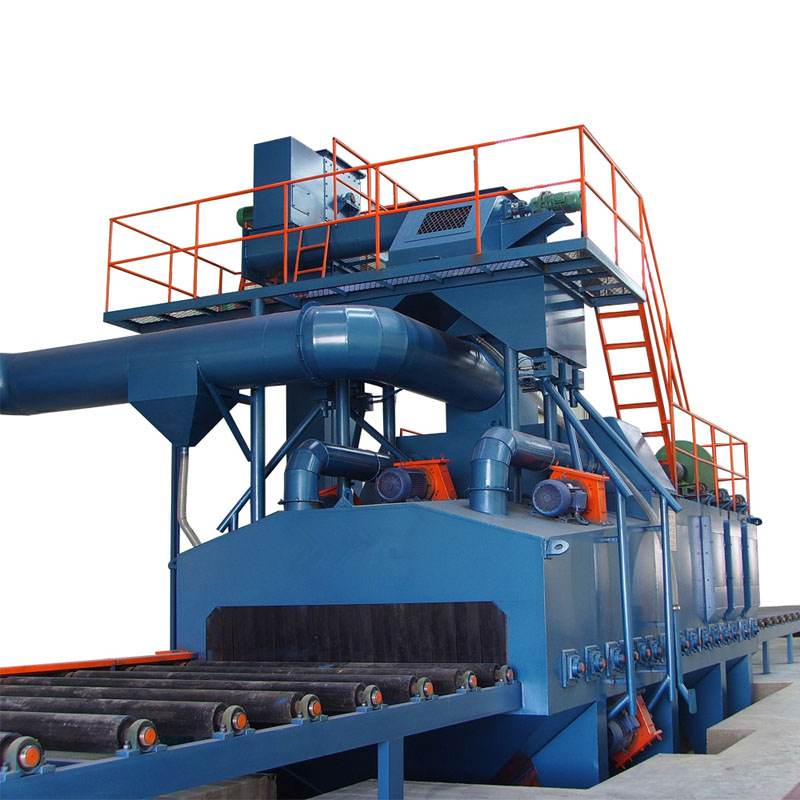The Power of Precision: Exploring the Benefits of Shot Blasting Machines
2025-03-13
In the world of industrial manufacturing, efficiency and precision are crucial to achieving high-quality results. One machine that plays a significant role in many production processes is the shot blasting machine. Used for surface preparation, cleaning, and finishing, shot blasting machines have become an indispensable tool in various industries, from automotive to construction.
But what exactly is a shot blasting machine, and how does it work? In this blog, we’ll dive deep into the importance of shot blasting machines, the various types available, and the significant benefits they bring to different industries.
What is a Shot Blasting Machine?
A shot blasting machine is a mechanical system designed to clean, strengthen, or polish a material's surface using abrasive media. The process involves propelling small, spherical media—known as “shots”—at high velocity onto the surface of the object. These shots can be made of steel, copper, aluminum, or ceramic, and the impact helps to remove rust, scale, paint, and other contaminants from the surface.
Shot blasting is often confused with sandblasting, but the two processes differ in the type of media used. While sandblasting typically involves using sand as the abrasive material, shot blasting machines use harder, more durable media, which makes the process more efficient and suitable for a variety of applications.
How Does Shot Blasting Work?
The operation of a shot blasting machine is fairly straightforward, but it requires precision and control for effective results. The process typically involves:
1. Loading: The object to be treated is placed inside the blast chamber or onto a conveyor belt, depending on the machine’s design.
2. Abrasive Impact: The machine uses a rotating wheel or a pneumatic system to accelerate the abrasive media (shots) toward the surface of the object. The shots hit the surface with high velocity, dislodging impurities and preparing the material for further processing.
3. Collection: After the shot blasting process, the used media is collected and recycled for reuse, making it an eco-friendly option.
4. Finishing: The object comes out of the shot blasting machine with a clean, roughened, or polished surface, depending on the type of treatment applied.
Types of Shot Blasting Machines
Shot blasting machines come in various designs to meet the needs of different applications. Some of the most common types include:
1. Hanger Type Shot Blasting Machines
These machines are ideal for handling large or heavy parts, such as automotive components or industrial equipment. The parts are suspended in the air and blasted with shots from all angles. This type of machine is highly efficient for high-volume cleaning or surface preparation.
2. Tumble Belt Shot Blasting Machines
Tumble belt machines are perfect for cleaning small, medium-sized parts in bulk. These machines use a conveyor belt to transport parts through the blasting chamber while rotating the parts for uniform coverage. Tumble belt shot blasting is commonly used in the automotive, metalworking, and manufacturing industries.
3. Floor Type Shot Blasting Machines
Designed for continuous processing, these machines are used to clean large flat surfaces, such as floors, runways, or ship decks. The abrasive media is propelled against the surface, removing dirt and debris to reveal a smooth finish.
4. Roller Conveyor Shot Blasting Machines
These machines are suitable for cleaning long and heavy workpieces like steel bars or metal plates. The parts are placed on a conveyor belt, where they are subjected to high-speed shots that clean and prepare the surface for further processing.
5. Portable Shot Blasting Machines
Smaller and more versatile, portable shot blasting machines are often used for on-site cleaning, especially in construction or infrastructure projects. They are useful for removing contaminants from large surfaces such as buildings, roads, or bridges.
Key Benefits of Shot Blasting Machines
1. Surface Preparation
One of the most common uses for shot blasting machines is to prepare a surface for further treatment. Whether it’s preparing a steel surface for painting or creating a rough surface for better adhesive bonding, shot blasting ensures the substrate is clean and ready for the next step in the manufacturing process.
2. Improved Durability and Resistance
Shot blasting not only cleans the surface but also strengthens the material. The process induces a compressive stress on the surface, which can increase the durability and resistance of materials like metal and concrete. This makes it particularly valuable in industries where wear and tear are concerns, such as automotive and construction.
3. Increased Efficiency
The use of shot blasting machines significantly speeds up the cleaning and finishing process compared to manual methods. With their ability to handle large quantities of parts quickly and efficiently, shot blasting machines can help businesses reduce production times and labor costs.
4. Eco-friendly
Shot blasting machines are an environmentally friendly option, as they use recyclable materials (the shots) that can be reused multiple times. This reduces waste and the need for disposal of hazardous materials such as sand or chemicals used in other cleaning processes.
5. Uniform Finish
One of the standout advantages of shot blasting is its ability to provide a consistent and uniform finish. Whether you are cleaning large, complex parts or polishing a surface, the machine ensures an even treatment across the entire object, which is crucial for achieving high-quality results.
6. Versatility
Shot blasting machines are used across a wide range of industries, from automotive to aerospace, construction, and even art. Their ability to clean, polish, and strengthen various materials makes them a versatile tool that can be tailored to fit specific production needs.
Applications of Shot Blasting Machines
1. Automotive Industry
Shot blasting is commonly used in the automotive sector for cleaning and preparing metal parts, such as engine blocks, wheels, and chassis components. The machines help remove dirt, rust, and scale, ensuring that the parts are free from contaminants before further processing or coating.
2. Construction and Infrastructure
In construction, shot blasting is often used for cleaning surfaces like concrete floors, roads, and bridges. It is also used to prepare metal components used in structural applications, ensuring better adhesion of coatings and protective layers.
3. Aerospace and Defense
For precision parts used in the aerospace industry, shot blasting helps create a clean surface free of impurities. This is essential to ensure that parts like turbine blades and landing gear have a smooth, durable finish that can withstand harsh environments.
4. Steel and Metal Manufacturing
Shot blasting is widely used in steel and metal manufacturing for cleaning and preparing metal surfaces, including removing oxides, rust, and scale that accumulate during the production process. This is crucial for improving the final product's finish and performance.
5. Art and Design
Shot blasting is also used in the creation of intricate designs and finishes for artistic applications. Artists use shot blasting machines to add texture to sculptures, metal artwork, and custom-designed metal parts.
Conclusion
Shot blasting machines are indispensable tools in modern manufacturing, providing an efficient and cost-effective method for cleaning, finishing, and strengthening surfaces. Whether in automotive, construction, aerospace, or metal manufacturing, shot blasting machines offer significant benefits, from increased durability to improved efficiency.
By understanding the variety of machine types and the wide range of applications, businesses can select the right shot blasting solution to meet their specific needs. Investing in high-quality shot blasting technology is a smart move for any industry looking to improve surface quality, enhance material longevity, and streamline production processes.



